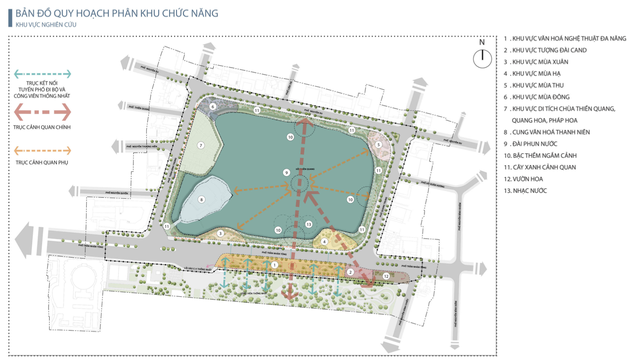The People’s Committee of Hai Ba Trung district has started collecting opinions from the community on the Urban Design Project for the area surrounding Thien Quang Lake, at a scale of 1/500. The research site covers an area of 11.7 hectares and is located in the two wards of Nguyen Du and Le Dai Hanh.
According to the urban design boundaries, this area borders Nguyen Du street to the North, Tran Binh Trong street to the West, Quang Trung street and Tran Nhan Tong street to the East, and Tran Nhan Tong street to the South.

Thien Quang Lake Urban Design, at a scale of 1/500: Map of functional zoning plan.
The consulting unit proposed a design consisting of 13 areas, including 5 important squares. The central square will be located along Tran Nhan Tong street, adjacent to Thong Nhat park. This will be a gathering place for cultural and artistic activities, a center for trade and commerce, as well as an ideal resting space for tourists. In addition, there is a square that connects the functional zones of the streets as well as connects with Thong Nhat park.
The other four squares are named after the four seasons and are located at the four corners of Thien Quang Lake. Each square has its own unique characteristics and features of the season.
Specifically, the Spring and Summer squares are located at the two corners of Tran Nhan Tong street. This is where major events and activities take place, providing an open space for people to enjoy the panoramic view of Thien Quang Lake.
The Autumn square is located near the intersection of Nguyen Du and Quang Trung streets, bringing a vibrant and lively atmosphere. Meanwhile, the Winter square is located at the intersection of Nguyen Du and Tran Binh Trong streets, serving as a transitional space between the lakefront park and the cluster of three pagodas: Thien Quang, Quang Hoa, and Phap Hoa. In this square, people and tourists can participate in activities such as playing chess, exercising, or fishing.
One of the highlights of the project is the design of a water fountain in the middle of the lake and a water music performance area near the shore along Tran Nhan Tong street. The viewing platforms will be built close to the lake shore, creating a relaxing atmosphere for people to enjoy. The project also aims to create other areas such as a statue of the police force, a religious area, a youth cultural center, and green landscapes.
The goal of the project is to transform the Thien Quang Lake area into a hub connecting residential areas and cultural centers, as well as becoming a gateway from the surrounding streets to Thong Nhat park. In addition to improving the urban landscape, the plan also aims to upgrade public utility systems and create versatile activity spaces with modern amenities.
According to the project, the construction will have all the conditions to become a scenic cluster, an attractive destination, and the main cultural and social center of Hanoi city. This will be a popular choice for sightseeing, entertainment, shopping, and serve as a central hub connecting the surrounding areas.
Once completed, the project will not only enhance the quality of life for residents but also increase the attractiveness of this area. According to a representative of Hai Ba Trung district’s Urban Management Office, the community’s opinions will be collected for 30 days, starting from the day the project file is posted on the district’s website and the drawing is hung at the headquarters of the Nguyen Du and Le Dai Hanh wards People’s Committee.





































